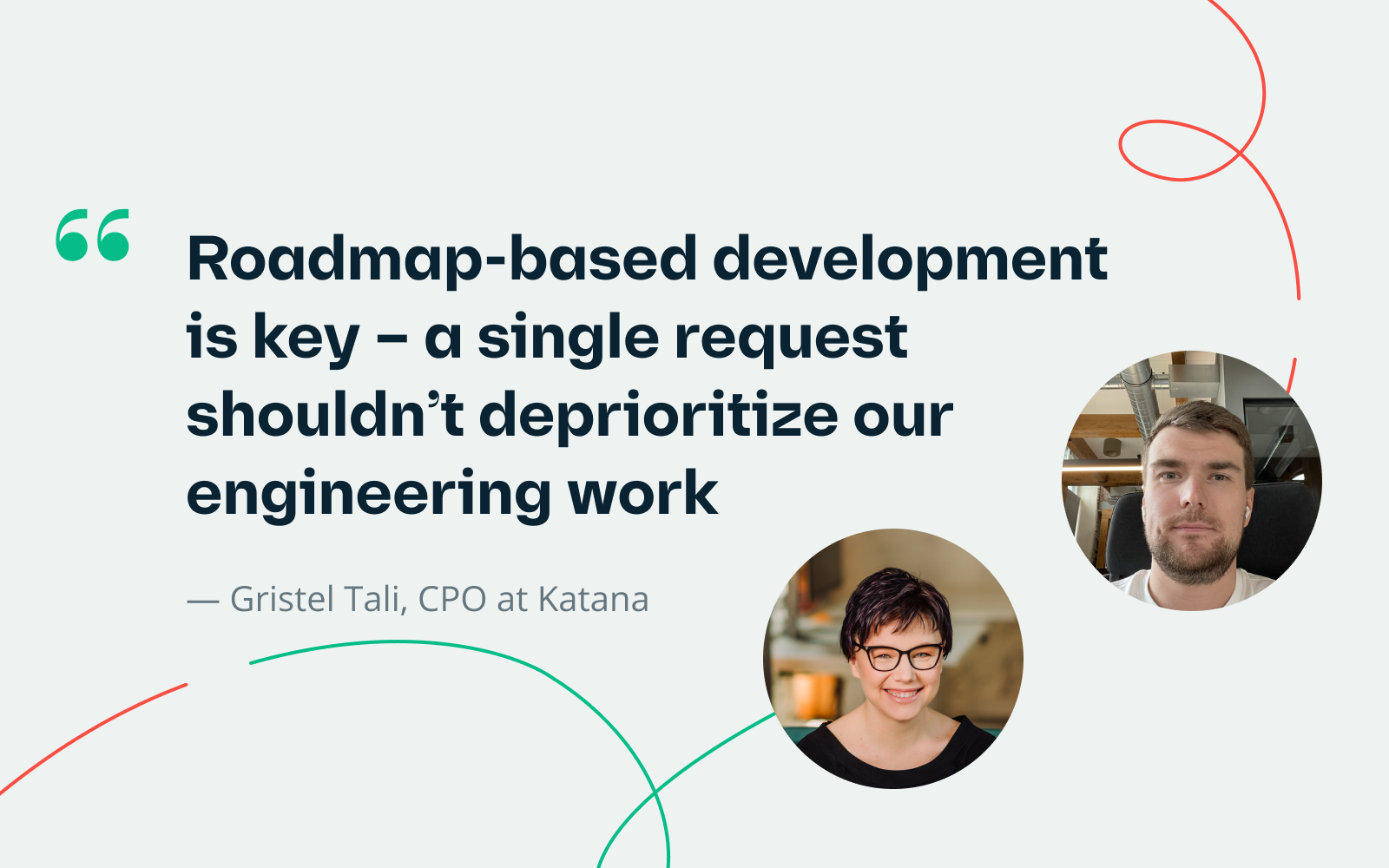A Q&A with Katana’s CPO and Head of Product Engineering on roadmap-based development
An interview with Katana’s CPO and Head of Product Engineering about what Katana has planned after Series B, and how we do things differently in our engineering department.

Sarah Hamid

With Katana’s Series B investment now announced, I set out to understand the impact this would have on the different departments within the company – starting with our Product Engineering teams. To find out what’s planned in the future, and how the teams might grow, here are all the details from Gristel Tali, our Chief Product Officer, and Ants Konga, our Head of Product Engineering.
Let’s start by looking at a day in the life of a Katana CPO and Head of Product Engineering.
Tell me about what you do in Katana
Gristel: Primarily, I’m building a better life for manufacturers! The main thing I do daily though is say ‘No’ – this is really the main thing a product manager should do; you can’t build everything. When ideas start popping up on all sides, the main thing you must master is saying no. Otherwise, they ruin your roadmap, and you don’t deliver anything.
I’m building a better life for manufacturers!”
Ants: And I’m supporting the growth of Katana concentrating on engineering leadership thus working with our product engineering leads to help them to be successful: recruit staff, lead their team, and ultimately motivate their people.
And that is my main mission within Katana – to scale our engineering teams, but also, taking ownership of Katana’s software delivery and deliverables.
How do you feel this Series B investment will help your department in the coming months and years?
Gristel: With our product, we’ve always had a long-term roadmap, and we knew what we’d be doing from Series B to Series C, and we already know a little about what we’ll do after our C round. Until our target customer shifts above the M level of SMBs, my job is clear – to use this investment to deliver for those medium-level manufacturers. We need to add more complex manufacturing processes into our feature offering, to accommodate these bigger customers, who have deeper needs in terms of the organization of processes.
Ants: For me, funding plays a key role in a couple of aspects. Firstly, the opportunity to staff current and new product engineering teams. With more engineering capacity we are able to deal with multiple roadmap items in parallel thus reducing the feature gap need to onboard M of SMB customer with a quicker pace.
It’s a three-pronged approach – hiring into product teams, enabling those teams, and giving them the right tools.”
Secondly, funding helps create ‘enabling’ teams. For example, we have the chance now to set up our platform team, which helps lessen the load on technology and minimize the technical debt that is created over time. An enabling team can assist with technical debt-related initiatives like framework upgrades, different migrations, and various cloud topics – they help us build foundations that our product engineering teams are using to build a stable and scalable product.
Finally, the funding enables us to make choices on technology and tooling which help us to move faster. Katana utilizes a ‘managed services’ approach – this means that where possible, we solve bottlenecks using technology, and then look for hiring profiles that would support this. It’s a three-pronged approach – hiring into product teams, enabling those teams, and giving them the right tools.
Thinking about the roadmap, is there anything that you’re really excited about?
Gristel: Katana will launch ‘platform play’ soon, hopefully early next year, which will be a much bigger app marketplace. We already have bits and pieces which are publicly available, but this will be a huge addition to our product. Of course, we need to develop features to meet the expectations of larger manufacturers, but we also need to provide a good ecosystem for those customers to operate in.
We already offer a lot of great integrations, but an app marketplace gives an opportunity to our partners, and our integrations partners, to offer their own custom integrations through Katana. They can then monetize this through our platform, which is good for the relationship between Katana, our partners, and our customers.
We also feel that using third-party apps within Katana should feel more like a native part of our platform. Today, our native integrations are easy to connect, but adding this app marketplace should allow all our existing third-party apps to become a one-click connection.
Of course, we need to develop features to meet the expectations of larger manufacturers, but we also need to provide a good ecosystem for those customers to operate in.”
Ants: For me, in general it’s creating of new teams, and what they’re ultimately building for Katana customers. So, starting our Warehouse and Marketplace teams is very exciting for me personally and to see how teams start to provide support for features that have been requested by a lot of customers.
Inspired by roadmap-based development?
Check out Katana’s open positions, and apply today to come and help us build a better life for manufacturers.
What’s the plan for growth of our product and engineering teams?
Gristel: The approach we take to engineering teams within Katana is ‘workflows’. So, each team will build their workflow, and then when users start using it, they don’t fall through gaps between teams — we always know who’s accountable for that workflow.
We’ve separated our team so that each workflow has its product manager, a product engineering team, and a product marketing representative. We scale this by adding more product engineering teams into the workflow structure. For example, we have our API and App Marketplace team which contains our API team, and we’re now building out our App Marketplace team.
The same thing will happen with our Sales and Shipping team — we have one product engineering team within this workflow right now, and we’ll add a new team with a product manager, engineering team, and all the relevant roles required.
Each team builds their workflow, and when users start using it, they don’t fall through gaps between teams — we always know who’s accountable for that workflow.”
We’ll add more engineering teams, but we won’t add any further workflows right now. The last new workflow was Warehouse, and right now the product manager and designer are preparing the groundwork so the new engineering team for this workflow can start working on it soon.
We definitely need more product managers, plus we’ll add an extra layer of research to our product team. Right now, product managers, designers, and product marketing managers do their research themselves, looking at different areas to help inform their decisions. Our new layer will gather all our research knowledge under one umbrella, so this can be accessed and utilized.
What do we look for in potential new Katanauts in our product and engineering teams?
Gristel: I look for ‘the spark’. Product managers ideally need a business background and some amount of industry knowledge. It’s great if they know how to do product management, but industry experience is crucial. If you’ve felt some of the pain our customers have, it really helps inform your day-to-day attitude. The sweet spot for us is if you have some amount of manufacturing (or, manufacturing adjacent) background, or real business experience. Otherwise, we have excellent product engineers, being led by someone who doesn’t necessarily know our industry well enough to translate the customer needs.
You can create the process and you know it’s logical, but you don’t know the stress points, or where bottlenecks might form. And waiting for customer feedback isn’t efficient enough, because we need to be able to identify and fix problems quickly, without customers needing to tell us, or anticipate the problems based on real-world experience.
Ants: In engineering the current profile is still someone with full-stack experience and preferably having a SaaS product building experience. However, what I’m looking for is something which is harder to define, and that’s ‘drive’. A self-motivated and positive individual. Obviously technical skills also play a large role — as we live inside a distributed ecosystem, working on numerous microservices previous experience comes in handy. Being able to use your experience in your new role or help teach others based on your experience is something we really value here in Katana. Knowledge sharing is very important!
Being able to use your experience in your new role or help teach others based on your experience is something we really value here in Katana.”
The advantage of bringing in this experience now is that as we grow bigger, potentially in 2023 or 2024, we’ll then be able to work with universities, and coding schools, to give opportunities to people who don’t have that industry know-how so we can be the first step on their journey.
What does Katana do differently in our product department that sets us apart from other startups?
Gristel: From feedback within the market, it’s the fact we have a long-term roadmap, and we refuse one-off customer requests to stick to that roadmap. For engineers – if you take on board all these one-off requests, the roadmap gets lost, and nothing is delivered. And even then, if you deliver all the requests, what is required can change while you’re building the new feature due to a shift for the customer, or that customer can even churn before you deliver their request.
A single customer request won’t make us deprioritize our engineering work.”
Developers want to build features, deliver them, and see how customers start to use them. That’s the feeling of achievement. We don’t take these small requests until we’re certain that there’s enough demand for them – multiple customers, or customers doing a lot of business within Katana.
Roadmap-based development makes us stand out. A single customer request won’t make us deprioritize our engineering work.
Ants: What I’ve heard from the market, and it’s not necessarily an engineering principle, is that Katana has a strong product vision. The big positive this has on engineering is that the vision doesn’t change on a daily/weekly/monthly basis – we don’t have massive pivots in our vision. The roadmap and deliverables remain, we’re not making one-off changes for individual manufacturers as Gristel said above.
We’re heavily invested in raising our platform and making improvements that will affect the majority of our customers. This makes life in our engineering department a lot easier. The focus also gives us breathing room in our work, as we avoid doing one-off tasks which could massively balloon the amount of technical debt in our code base.
And finally, what makes Katana special for you personally?
Gristel: I like Katana because our people are allowed to be themselves. You don’t need to fit a certain mold, you can be who you are and define your own success.
For a developer, being able to make suggestions on the technical stack, frameworks, and using these cutting-edge technologies is extremely cool.”
Ants: What I really appreciated coming from a very hectic corporate type of environment is how good the company culture is. Also speed on which technologies can be investigated and adopted is extremely impressive. For a developer, being able to make suggestions on the technical stack, frameworks, and using these cutting-edge technologies is extremely cool. In startup environments the speed of change from technology side makes it an extremely motivational environment to be a part of.
Thank you to both Ants and Gristel for taking the time, and if you like what you’ve read, you can check out our open positions on our careers page right now. Who wouldn’t want to build a better life for manufacturers?

Sarah Hamid
Table of contents
Get inventory trends, news, and tips every month
Get visibility over your sales and stock
Wave goodbye to uncertainty by using Katana Cloud Inventory for total inventory control
